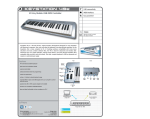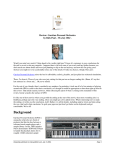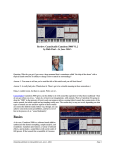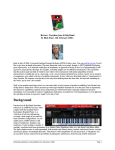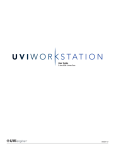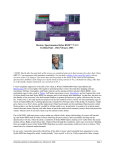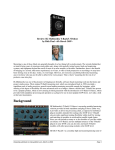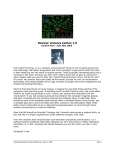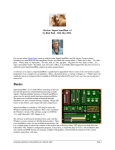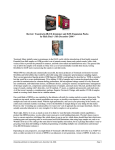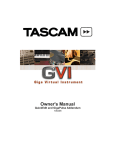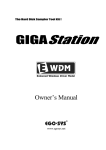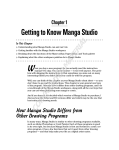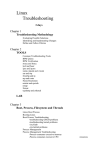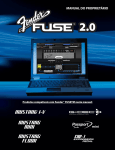Download Review: Spectrasonics Trilogy™ by Rick Paul - 27th March 2004 -
Transcript
Review: Spectrasonics Trilogy™ by Rick Paul - 27th March 2004 - Over the past roughly one and three quarters years, I have written an even dozen software and sample collection reviews for CakewalkNet.com. As much as I have looked forward to trying out many of those products, I can honestly say I have never started a review with as much anticipation as this review of Spectrasonics' Trilogy. Why? There are a few reasons: Perhaps the biggest reason is Trilogy's lineage, which, in and of itself, would serve to create high expectations. Spectrasonics was founded by one of the music industry's leading sound designers, Eric Persing. For anyone who doesn't take much note of the people behind the scenes in designing the instruments and sounds they use to create music, for approximately 20 years now, Persing has been involved heavily in designing sounds for Roland instruments. We're talking everything from classics like the D-50 (Digital Native Dance and Fantasia were among the ultra-popular sounds programmed by Persing) and Jupiter 6 to modern day Roland flagship offerings such as the XV-5080, V-Drums, and the VP-9000. Persing and Spectrasonics have also created some of the industry's top sample libraries, including such noteworthy titles as the Hans Zimmer Guitars and Distorted Reality series. Secondly, Spectrasonics' positions Trilogy as a "total bass module", noting that it, "was the first and only virtual bass instrument on the market dedicated to acoustic, electric and synth basses." That name conjures up thoughts of having a be all and end all bass software instrument solution. Bass is such an essential instrument category that a virtual instrument that covered these three bases well enough could easily end up being used on almost all of my projects. Yet there was also the question as whether a single sample-based software instrument could be this sort of Holy Grail of bass instruments. For example, how could a sample-based instrument compete with fully programmable softsynths when it came to synth bass sounds? And could Trilogy really take things to another level when it came to acoustic and/or electric basses? We'll take a look below at what Trilogy is and isn't, and whether it justifies my initial level of anticipation. However, before we look at Trilogy in more depth, let's cover some basics. Originally published on CakewalkNet.com, March 27, 2004. Page 1 "Bassics" Trilogy is a programmable, samplebased software sound module with a core sample library of approximately 3GB dedicated to acoustic, electric, and synth bass sounds. Its sound generation comes from a custom version of UltimateSoundBank's 32bit UVI engine. Spectrasonics' implementation adds a layering concept whereby each patch has two layers that can be adjusted independently. The layering can allow mixing different characteristics from the same instrument -- e.g. mixing direct pickup and mic layers from an acoustic bass -- or to create hybrid instruments by mixing components from different instrument sounds -- e.g. mixing an acoustic bass with a synth bass. The Trilogy package includes multiple plug-in formats (MAS, RTAS, and VST for the Mac; VST only for the PC), along with the monolithic sound library and a user manual. (Since this review is directed mainly at users of Cakewalk products, such as SONAR and Project5, we will only look at the Windows VST version of the plug-in, running it under Cakewalk's latest VST Adapter as supplied with SONAR 3.1.1 and Project5 1.5.) The sound library is reconstructed at installation time from components spread across 5 CDs. The 49-page user manual that more than adequately covers what you need to know to get running up and running quickly with Trilogy. Software installation, though somewhat time consuming due to having to rebuild the 3 GB sample library from 5 CDs, is straightforward. Authorization, via Spectrasonics' web site is required within 48 hours, and the software protection is tied to your hardware, though the authorization can be performed on another computer if the computer on which the software is being installed is not attached to the Internet. While this form of copy protection generally carries with it several concerns (e.g. what happens if the vendor goes out of business and you need to replace your hard drive?), an updated list of Frequently Asked Questions (FAQs) on Spectrasonics' web site indicates that Spectrasonics has made provisions for most types of eventualities that could arise. They even indicate that they have set up a contingency system to provide authorizations in the unlikely even that Spectrasonics were to go out of business. Trilogy's authorization is also painless and quick, by the way. It is worth noting that the Trilogy license is a single user license, not a single machine license. For example, if you purchase a license for Trilogy, you can use it on both a desktop and laptop computer. However, it would not be acceptable for two different people to use Trilogy on the same computer. Each user would need his or her own license. This could create complications for some environments, such as in a commercial studio where computerbased instruments would be used like studio-owned rack instruments of yore, where use of the instruments might have been included in the studio rental. (Spectrasonics indicates that site licenses are available for situations like this. Contact Spectrasonics for details.) It isn't likely to be an issue for the typical home or project studio user, though, and the possibility of having multiple installations for the same user will be a selling point for those who use one computer in the studio and another on the road. Kudos to Spectrasonics for making the licensing terms clear -i.e. in English, not legalese -- not only in the paper manual, but also at software installation time. This is the first time I recall having seen any software provide licensing terms that actually invited the user's reading them rather than just blindly hitting "Accept" to continue with installation. As you might guess, Trilogy requires a lot of disk space -- approximately 3.1GB of free space -- for installation of the core sample library and relatively small VST plug-in. What might not be as obvious is that you also need a reasonably healthy memory configuration. The Trilogy specifications require a minimum of 512 MB RAM. However, in practice, you may find that 512 MB is insufficient to run some of the larger Trilogy samples under Windows XP and SONAR 3.1.1. This is especially the case if you want to run other memory-hungry softsynths, or Originally published on CakewalkNet.com, March 27, 2004. Page 2 use sample loops, alongside it. I would be inclined to recommend a larger configuration -- at least 768 MB, but preferably even 1 GB -- for practical usage. I will also note, though, that this review was conducted on a 512 MB system (I was just careful in my sample selections to keep memory usage manageable for each specific project). List price for Trilogy is $349. At the time of this writing the best street price I could find was $319. Covering the Basses In developing an instrument or set of sounds, there is often a tradeoff between depth and breadth. You can either try to do a small number of things very well, or you can try to do a large number of things at least passably. By confining Trilogy's scope to being a bass module, Spectrasonics is, in some senses, limiting the breadth in favor of depth. However, the bass function is still a pretty diverse category, with acoustic basses, electric basses of various types, and an even larger number of synth bass options. Trilogy covers all of these areas, and covers them in a way that provides better coverage for each area than most options to date have provided. Thus, it is fair to say that Trilogy is going for both depth and breadth, albeit within a specific functional scope in the latter category. Trilogy's acoustic bass coverage decidedly goes for depth. Most of the patches specifically focus on capturing one upright bass, but provide extreme flexibility for using that upright bass. At the high level, Spectrasonics provides both mic (Neumann U47 through a Neve 1081 console preamp) and DI patch categories, as well as a category that allows you to choose your own mix of mic and DI signals and a muted category. Within each patch category there are upwards of 20 individual patches in all but the muted category. Some patches lean more toward realistic real time playability, while others lean heavily toward real-time control of specific aspects of the sound such as slides, harmonics, squeaks, and glisses. We'll get into more specifics of Trilogy's special features for playability and realism below. In addition to the upright bass patches, there is also a set of Martin acoustic bass guitar patches for anyone going for that "unplugged" sound. On the electric bass front, Trilogy goes for more breadth, while still going relatively deep. At the high level, bass patch categories are divided up into fingered, fretless, muted, picked, and slapped basses. Within each of those five categories are 3-6 subcategories for individual instruments. For example, within the muted category, there are subcategories for classic, hip-hop, R&B, and reggae. Finally, within each instrument subcategory, there are multiple patches for real-time playability or fine control as applicable to the specific type of instrument and type of articulation. We'll get into some of these options a bit more below. When it comes to synth basses, Trilogy is all about breadth, with depth provided primarily through Trilogy's sound tweaking capabilities, which largely come from the UVI engine and Trilogy's patch layering capability. At the high level, there are two categories, patches and waveforms. Patches are organized by sound type, taking full advantage of Trilogy's programming to achieve sounds that are intended for direct use in your recording projects, or at least for use with a minimum of tweaking on the user's part. Waveforms are raw multi-sampled classic analog synth sounds intended as building blocks for creating your own sounds. The waveforms do not use Trilogy's filters, thus providing more neutral raw materials to be used as a starting point in your own sound design. In both cases, the patches come from a virtual who's who of classic synths. There are too many models to name here (you can find a full patch list at http://www.spectrasonics.net/instruments/trilogy_patch.html), but just to give you a flavor, you will find models from ARP, Moog, Oberheim, Roland, Yamaha, and many more. If you are starting to get the impression that Trilogy covers a lot of ground when it comes to bass sounds, you are absolutely correct. Of course, broad coverage doesn't always mean quality coverage, or the flexibility to stray beyond the choices specifically on offer. Thankfully, Trilogy provides both. Let's look at these areas in more detail. In Search of Reality For those of us seeking realism in acoustic and electric bass sounds, Trilogy starts out with large, multi-sampled sounds -- Spectrasonics indicates that some of the basses in Trilogy have as many as 1,000 samples in a single patch. Originally published on CakewalkNet.com, March 27, 2004. Page 3 Let me try to add a bit of quantification here. The largest acoustic bass sample I'd ever used on one of my projects prior to Trilogy was less than 5 MB in size. I believe the smallest "normal" (i.e. non-special purpose) acoustic bass patch in Trilogy is over 20MB in size (over 40 MB if 32-bit mode is turned on). The one I've used the most thus far is over 260 MB (it defaults to 32-bit mode), and that is still considerably smaller than the largest acoustic bass patch in Trilogy. Since Trilogy doesn't stream its samples off disk, this is where those large memory requirements mentioned above can come in. The upside is more notes get sampled at more velocity levels, and this provides for more expressive playing. Trilogy doesn't stop at large sample sizes, though. It provides a number of features that add to the potential for realism. Some of these provide for new playing techniques that work around typical sampled instrument limitations. Others permit a level of patch programming that provides for enhanced realism without having to stray too far from normal keyboard playing techniques. At the most basic level, Trilogy's two sample layers allow blending sound elements. Spectrasonics takes advantage of this by providing electric and acoustic basses with a release noise layer that is blended in with the main sound samples, for example to add string noises such as squeaks when a note is let up. These release noises can be mixed independently of the main sampled sounds to emphasize them or de-emphasize them according to taste. These levels can even be automated via MIDI continuous controllers to change their balance over the course of a track. In practice, though, the programming by Spectrasonics is superb out of the gate, and the level of realism that comes "for free" is a cut above anything I've used to date. Some of Trilogy's samples have what Spectrasonics refers to as "velocity glisses" -- i.e. velocity-sensitive string glissandos (or "glisses" for short). In a patch with velocity glisses, most playing levels will just play the note you are playing, but, if you hit the note hard enough (MIDI velocities 126-127), you will get a gliss up to the note. While it adds a bit of a learning curve for trying to play this in real time, it is only a bit, and can provide a greater sense of realism than would be possible without this feature. It also does this in an easier-to-use fashion than, for example, trying to achieve something similar with the pitch bend wheel. With Trilogy, Spectrasonics introduces a featured called True Staccato™, whereby staccato samples are mapped three octaves above the corresponding sustained notes. Alternating staccato notes with sustained notes provides for much more natural repeated notes than are typically achieved by repeatedly playing a single note on a sampler. It can take a little while to get used to playing a bass part using two hands in this way, but the opportunity for achieving significant enhancements in realism makes it worthwhile to learn. This capability also makes it possible to revisit MIDI tracks created without True Staccato to edit them to take advantage of True Staccato, and thus to achieve greater realism in the case of staccato and/or repeating notes. I wasn't quite getting as smooth as I'd have liked in playing parts with True Staccato in real time. However, it was a simple matter to go back and edit the MIDI parts in SONAR's piano roll or notation editor, simply selecting the notes I wanted to change to staccato and transposing them up three octaves. A related feature relevant to picked electric basses is True Upstroke. Instead of providing a staccato version of the note a note three octaves above the sustained version like True Staccato, True Upstroke provides an upwardly picked note three octaves above the downwardly picked version. This again adds to the realism possible with repeated notes and other quick successions of notes where a real bass player would change picking directions between notes. In patches configured for either True Staccato or True Upstroke, the last few notes toward the bottom of the mapped sample range are used for commonly used slides. This is something that is impossible to simulate via normal keyboard playing techniques. Full patches of slides are available for use in programmed MIDI parts or other bass parts built from multiple instances of Trilogy layered together. However, this addition to the live playing-oriented modes provides a nice touch for selectively adding excitement to parts that are played live once you get used to what is where in the keyboard range. Speaking of alternate patches for building more involved programmed parts, Trilogy provides alternate patches for various special purposes such as slides, glisses, harmonics, squeaks, thumps, release noise, and more, depending on Originally published on CakewalkNet.com, March 27, 2004. Page 4 the specific type of bass and what is most applicable to the playing techniques for that instrument. Trilogy is not multi-timbral, but you scan use multiple instances of Trilogy in parallel for programming more complex parts that require multiple Trilogy patches for their components. Moving out of the playing techniques area and into the recording area, Trilogy provides both microphone and DI variations of the patches for upright acoustic bass, as well as a dual version that allows mixing the phase-matched mic and DI signals to taste. As it is common recording practice to mix miked and DI signals, this adds a nice touch. Since Trilogy's electric bass sounds were recorded direct, users who want an amplified bass sound could use an amp simulator plug-in, such as Amplitube, on Trilogy's output, and this provides excellent flexibility in fine tuning the sound. A mix of direct and amplified signal could then be achieved by mixing the direct output of Trilogy with the amp simulator's output. In SONAR 3, this can easily be achieved by putting the amp simulator on a bus. A pre-fader insert would be created on the Trilogy audio track to feed the direct Trilogy signal to the amp simulator's bus, then both the Trilogy track's output and the amp simulator bus' output would be blended to taste on the main mix bus. All in all, if you're looking to create realistic acoustic or electric bass parts with Trilogy, you'll get closer right out of the shoot than with any softsynth or softsampler I've tried to date. If that's still not close enough, Trilogy provides additional features to let you take things even near your ultimate goal. If you want to get closer still, you may just have to break down and hire a real bass player, and, of course, have good enough recording techniques to capture the playing with the same kind of sound quality Trilogy provides. Bend Me, Shape Me When I first heard about Trilogy, I thought it was a great idea to have a module dedicated to providing top quality acoustic and electric bass sounds. However, I was less thrilled with the notion of using a sample-based module for synth sounds. After all, why not just use synth modules, rather than settle for someone else's ideas on what sounds from that synth were worth sampling, and having the inherently narrower set of possibilities than you would get through the continuous editing controls on a softsynth module. For example, if a Minimoog bass was desired, it would seem you'd get more flexibility with something like Arturia's recently announced Minimoog V, which would let you program any sounds you could program on a real Minimoog, than you would with a limited set of samples of Minimoog sounds. Of course, the other side of the coin is that sampled synth basses capture the actual tone of the vintage instruments being sampled, whereas softsynths are necessarily attempts at recreating the sounds of those vintage instruments and/or their sound generation logic. Different softsynth vendors will have varying degrees of success in achieving accuracy in their models. Not to mention that there are still vintage instruments sampled in Trilogy that have not yet been accurately modeled. While I still think someone who is truly into programming synth bass sounds themselves, and has a favorite synth module or three, may prefer going the dedicated softsynth route for greater programming flexibility, Trilogy provides a number of benefits over the dedicated softsynth route. It also provides a lot more programming flexibility than I might have initially envisioned. We'll get to the programming capability, which, by the way, is not limited to use with synth bass sounds, in a moment, but the other key benefits are the head start having a number of high quality preprogrammed sounds provides (how much of an advantage that is will depend on what is being compared), getting a wider variety of sound characteristics than you would with just one or two dedicated softsynths (i.e. since Trilogy provides samples from a large number of synths), and a huge cost advantage over trying to collect a large number of softsynths for creating your own synth bass sounds from scratch. In fact, on that last count, if you need even two different types of synth basses, odds are you will save some money going with Trilogy, and don't forget you get the acoustic and electric basses in the process. Let's move on to Tweakersville, though, shall we? There are two main categories of sound tweaking capabilities in Trilogy. Each individual sound can be altered with synthesizer like controls, such as amplitude, filter, and pitch envelopes. We'll get into the specific controls available shortly, but, to summarize, these controls are similar to those available for Originally published on CakewalkNet.com, March 27, 2004. Page 5 subtractive analog synthesis. The second category of sound tweaking capabilities comes from the ability to mix two component sounds to form one composite sound. Some synth vendors use the term "partial" for the component sounds and "patch" for the composite sounds, but Spectrasonics just calls the individual sounds "layers", and a patch either has a single layer or dual layers. There are two layers, A and B, available in each Trilogy patch. The two layers can be blended together in Trilogy's mixer. Controls there include level faders, pan, and coarse and fine tuning controls (in semi-tones and cents, respectively) for each of the layers, as well as on/off buttons for each layer. With the large variety of sounds in Trilogy, and the ability to load any component sample set into any layer, a fair amount of sound design capability comes with simply mixing two layers together. For example, you could take a picked electric bass sound and combine it with a mellower synth bass sound to get a sound with more bite than the synth bass sound that still had its warm sustain. This degree of control may very well satisfy some users who don't really want to get down to the nuts and bolts level, but still wish to go beyond preset sounds. For the real tweakers, though, a lot more control is available down at the level of the individual layers, and via a few global controls that are mixed in with the layer controls in the organization of Trilogy's user interface. Toward the top middle section of the layer tweaking interface are layer toggle buttons to select which layer is the active layer for editing at any given time. In the screen shot at right layer B has been selected for editing. The field below the layer selector indicates that the sound loaded into that layer, here "OSCar Blown Tubes". There is also a button/light between the two individual layer selectors to link the two layers such that changes made in one layer are also made in the other layer. This does not affect sound loading into the layer, nor does it reset all controls in the other layer when one layer is loaded. It only affects controls adjusted while the link function is enabled. Up near the top left of the layer tweaking section is a modulation matrix which allows determining what modulation sources will control the active layer's pitch filter, amplitude, and panning. Modulation sources include dedicated layer-specific envelopes (i.e. pitch, filter, and amplitude), common MIDI data values (e.g. key position, aftertouch, velocity, pitch bender, mod wheel, assignable continuous controller), layer-specific or global LFOs, and some special sources (e.g. an LFO with the amount of modulation controlled by the mod wheel, alternating positive/negative values with each successive trigger, random values with each successive trigger). Associated with each modulated attribute is a depth dial and a polarity light/button. The dial determines the absolute value of the maximum depth of modulation, and the polarity light/button both indicates the current polarity by its color and can be pressed to toggle the polarity between positive and negative. Thus, for example, for one layer of a patch, you could have pitch modulation controlled by the pitch bender, filter modulation and amplitude modulation both controlled by keyboard velocity, and panning modulation set randomly. Note that these settings are used to modulate the relevant values in the current layer rather than for directly setting those values. For example, the actual pitch at any given point will come from a combination of the note being played (i.e. as related to sample mapping), any pitch envelope in force within the layer, and whatever pitch modulation may be coming into play here. Originally published on CakewalkNet.com, March 27, 2004. Page 6 In the bottom left corner of the layer-oriented controls are Trilogy's layer-specific pitch envelope controls. These include a depth dial for adjusting the absolute value of the amount of pitch modulation available from the pitch envelope, a polarity light/button to control whether the pitch modulation goes up or down, and a time dial to set the pitch envelope's decay/release time. Short envelope times with nonextreme envelope depths can achieve bending type articulations on notes. Leaving the depth control at zero effectively turns the pitch envelope off. Just to the right of the pitch envelope controls are Trilogy's LFO controls. Trilogy provides 4 LFOs, two of which are independent per layer and two that are global. To set these, you select one of the LFOs via numbered buttons/lights, then adjust the LFO depth and rate controls for the selected LFO. LFO1 and LFO2, which are the ones that are independent per layer, have their phase restarted with each MIDI note on message. LFO3 and LFO4, which are the global LFOs, do not get restarted with each note on, but rather keep running continuously. The differences here lend themselves to different applications. For example, LFO1 or LFO2 would generally be used to create effects such as vibrato that tend to be specific to a note being played. LFO3 or LFO4 would be more appropriate for overall effects such as automatic panning. Note, though, that just because LFO3 and LFO4 are independent of the layers doesn't mean they can't be used to affect layer-specific parameters. For example, they could be used as modulation sources in the layer-specific modulation matrix. At the bottom center of the layer-oriented controls is the filters section. There are actually two filters in this section, one of which is independent per layer and the other which is global. Across the top of the section are the main parameter dials for the layer-specific filter. Those controls include the cutoff frequency, resonance, keyboard tracking amount, and filter envelope depth. Below those on the left are toggle buttons that select the kind of filter employed. Besides an "off" option (i.e. no filter), there are a high pass filter and three different types of low pass filters. The cutoff frequency setting here can be modulated by the filter-oriented controls configured in the modulation matrix. Toward the bottom right of the filters section is the global master filter, along with its resonance control. The master filter can be a high pass filter or low pass filter, depending on whether its slider is to the right or left, respectively, of its center point. Up at the top right of the layer-specific section are the filter envelope controls. In addition to standard ADSR (attack time, decay time, sustain level, and release level) controls a velocity time modulation knob adjusts the amount of effect MIDI velocity has over the attack or decay time, depending on whether "A" or "D", respectively, is selected on the velocity time modulation button just beneath the knob. That is, the knob does double duty, and toggling the button will bring back the knob setting related to the current state of the button. There is also a velocity sensitivity knob that adjusts the amount of dynamic control MIDI velocity has over the filter envelope's output. Below the filter envelope controls are the amplitude envelope controls, which are also layer-specific. Most of the controls here are as for the filter envelope section, except that they affect the amplitude envelope for the layer rather than the filter envelope. In addition, there is a sample start offset knob, which allows moving the start point of the layer between the start of the waveform and the start of the waveform's loop point, essentially changing the shape of the initial portion of the waveform by starting somewhere beyond the beginning. The effect of this is most noticeable with waveforms with distinctive transients at their start as the character of the transient can be radically altered by lopping off its initial portion. For example, using this knob with an acoustic bass sample can progressively make it sound more synthetic, then muted. Originally published on CakewalkNet.com, March 27, 2004. Page 7 Way over on the far right of Trilogy's user interface lies an assortment of additional controls. Up at the top is a preview button, as well as a MIDI note value display to indicate what note Trilogy will play when the preview button is pressed. This facility is handy for testing sounds away from a keyboard, though it would also be handy to have some way of specifying the MIDI velocity to be used for the preview. Just below the preview controls are the global velocity curves that determine how the patch will respond to MIDI velocity. The four curves available are linear, exponential, inverse exponential, and flat (i.e. no velocity sensitivity). Just below the velocity curves are the solo button and related glide control. The solo button puts Trilogy in a mono legato mode similar to that found on some analog synthesizers. If the solo button is engaged, then the glide control, which is configured independently for each layer of the patch, will control the degree of slide, or portamento in analog synthesizer lingo, between notes. Down in the lower right corner are several patch-level controls including a voices control to set Trilogy's maximum polyphony (which has an impact on CPU usage -- i.e. the greater the polyphony, the more demanding Trilogy is on the CPU), an octave shift control, a pitch bender range control, a MIDI continuous controller number assignment (i.e. to determine which MIDI CC is used when "CC" is selected as a modulation source), and a toggle to turn 32-bit mode on or off. To summarize, Trilogy provides significant capabilities for tweaking its basic sounds, both at the individual layer level, and at the patch level. These may even go beyond the controls available in some simple subtractive synthesizers, thus blurring the lines between sample playback and synthesis, and giving Trilogy a good deal of sound sculpting power in the process. Remember, too, that you are not only getting synthesizer-style controls to use with synthesizer style sounds. You can also use these same controls with acoustic and electric bass sounds, or can even create hybrid instruments that are part acoustic and part synthesized. Somehow I suspect my other synth modules will see a lot less action, at least for use on bass tracks. Playing Around It's one thing to explore the capabilities of a product, and quite another to actually apply that product to useful work. One of the first things I like to do in my product review process, after briefly exploring the product's capabilities, is to put it right to work on a real project. The goal is not only to see how well the product can ultimately be made to fit into the project in terms of sound quality, fitting in the mix, and so on. It is also to see how easy the product is to use in terms of efficiency, and whether it is actually fun to use, an exercise in frustration, or somewhere in between. I ended up using Trilogy on a couple of projects, and trying it out on several other projects, during the course of preparing for this review. The first of the projects was a new song demo that I was building from scratch, where I could actually play Trilogy in real time, recording the MIDI live then editing it as needed thereafter. The song was geared toward modern pop/rock, but had a bluesy flavor, and I wanted an electric bass that would lean a bit more toward R&B or modern radio pop while still fitting into a largely guitar-oriented arrangement. So many (good) choices, so little time... I ended up using a True Staccato version of Trilogy's Hip Hop Muted Bass, and it was just what the doctor ordered. In particular, the True Staccato feature was key to getting the kind of groove I wanted happening in a fairly busy bass part, and the slides available at the lower end of the keyboard in that patch also gave me some very nice energy in strategic places in the track. My newness to the playing technique needed to use the True Staccato feature effectively meant a fair amount of editing after the fact, but it was fairly straightforward, and quick, editing, and well worth the effort for the extra level of realism that resulted. The second project was a remix of a country rock shuffle, where I was replacing another sound module on an existing bass part. While the part was obviously not tracked for True Staccato mode, I again selected a True Staccato patch, this time from one of the Fingered Bass options, and simply edited the part to take advantage of the True Staccato feature. I had a very tight deadline on that project, so it was important that this editing could be done Originally published on CakewalkNet.com, March 27, 2004. Page 8 quickly, and the resulting part sounded good, but probably not as good as it might have had I actually tracked the part using Trilogy at the start. Even so, it was a significant improvement over the original bass part, so I can't complain at all. It's just that I was spoiled by the previous project, where I was tracking directly with Trilogy. Other projects I tried Trilogy on were just quick sound substitution efforts, just to see how Trilogy might plug into the context of a previously existing mix. In particular, I was interested in gauging whether I could significantly upgrade the sound of each project simply by replacing whatever modules were used for bass on the project with Trilogy. The projects were mixed in terms of the types of bass tracks they employed, including some acoustic, electric, and synth basses. In all cases, there was definitely some improvement potential, and now I will definitely have to deal with the feeling I'd like to redo a number of my projects simply to upgrade the bass parts. I guess that's both the good news and the bad news. Closing Notes What can I say? Spectrasonics' claims that Trilogy is a "total bass module" are right on the money. I hope my other softsynths and samplers weren't too attached to being used for bass parts on my projects, because I think they're not going to see much action in that area in the future. I don't always know what kind of bass part I'm going to want to use when I start a project. The idea that I can plug in one software instrument and be pretty much assured I will be able to fairly easily find a sound that will work for the part makes the decision as to which module to choose first an easy one. That in and of itself is a big improvement over having to switch modules, reconfiguring MIDI and audio outputs, to choose a sound, and just generally not knowing which module will end up being used. That Trilogy is also likely to end up providing better sounds, perhaps significantly better sounds, in many cases, means I have less call to even try out those other modules. I do have a relatively small wish list, though. For one, I do wish Trilogy had implemented disk streaming. While, all things being equal, memory resident samples are more efficient to access than samples streamed from disk, my practical experience is that GigaStudio- or KONTAKT-style disk streaming performs very nicely in my environment (Athlon XP 1600+ with 512 MB RAM running SONAR 3.1.1 under Windows XP). When using multiple large samples, disk streaming can also dramatically reduce the potential risk of running low on, or possibly out of, memory. As it is, using some of the largest Trilogy patches in real projects (i.e. ones that typically do have other memory-hungry plug-ins) will require me to upgrade my memory configuration beyond my current 512 MB level. Even some of the less extreme Trilogy patches can put an already tight project over the edge. This is "fair", in the sense that Spectrasonics requires a minimum of 512 MB, and running other memory-intensive programs logically would raise the requirements. However, for perspective, the largest sample in Trilogy is still less than half the size of the 1 GB GigaPiano sample that I have frequently used in GigaStudio 96 running alongside SONAR on the same system, or with KOMPAKT running as a plug-in inside SONAR on that same system. I do realize that memory is relatively cheap these days, but, for whatever reason, I always seem to be moving toward the edge of however much I have at any given point in time. I also know that, even after I upgrade to 1GB, hopefully soon, there will come a time when I'll get back to the edge again, and then I'll again wish some of my more memory hungry sample-based plug-ins would stream from disk. Mind you we are talking about ways to make a superb product even better, not a showstopping product fault. I also wish some of Trilogy's user interface were more intuitively laid out, with less mixing together of the layerspecific and global controls, and no double duty controls. I realize this could have consumed a bit more space, but I feel it would have been worth the tradeoff. (I might note here that I run a 19-inch CRT monitor at 1280x1024 resolution.) In particular, there is a fair amount of stopping to think which mode the various double duty controls are in when needing to interpret their value, and that can also lead to accidentally setting the wrong parameter. I'm not sure if I'd go so far as to suggest having the controls for the independent layers not be shared as that would roughly double the screen real estate needed. However, controls such as the velocity attack/decay time modulation knobs in the filter and amplitude envelope areas are cases where a little extra space could have made for significant clarity improvements. Not to mention that removing the attack/decay toggle buttons would recover a bit of that extra space. On a related note, the user interface comments above are really only relevant when editing sounds, and it is probably the case that many users will just select presets and go. (I probably number among those users a large percentage of Originally published on CakewalkNet.com, March 27, 2004. Page 9 the time since I use electric and acoustic basses much more frequently than I use synth basses.) In such cases, it might even be beneficial to have the option of a cut down version of the interface with only the patch selections and any global parameters. There could then be a toggle button to expand the interface for editing. In that case, even adding significantly to the screen real estate when expanded into editing mode might not be a problem since it would only be used when doing editing work. This approach has proved useful in some of the other products I've used such as Native Instruments' KONTAKT, where a browser window only needs to be open when loading patches, and detailed editing controls only need to be open when editing those particular parameters. This would definitely be in the "nice to have but non-essential" category. Relatively minor niggles aside, SONAR and Project5 users, and other DAW users for that matter, looking for a solid "go to" plug-in instrument to hold down their bass parts should definitely check out Trilogy. Just be forewarned that doing so could be hazardous to your credit card balances, and any other modules you've been using for bass parts to date could start getting jealous. *Rick Paul is a songwriter living in Southern California. You can contact him at http://www.RickPaul.info. Originally published on CakewalkNet.com, March 27, 2004. Page 10










